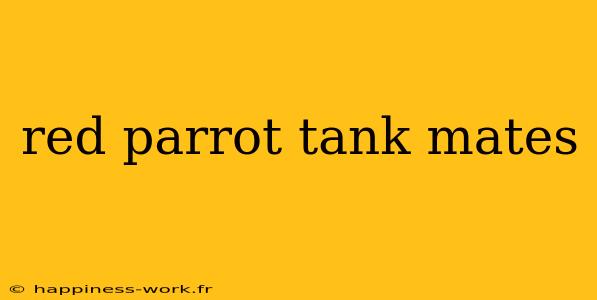Red Parrot Cichlids are vibrant, colorful fish known for their unique shape and engaging personalities. If you’re considering adding tank mates to your Red Parrot Fish aquarium, it’s essential to choose compatible species to ensure a harmonious environment. This guide will help you understand the best tank mates and additional factors to consider for a thriving aquatic community.
Understanding Red Parrot Fish Behavior
Before diving into potential tank mates, it's crucial to understand the behavior of Red Parrot Fish. According to WikiHow, these fish are typically peaceful but can exhibit territorial behavior, especially during breeding or when establishing dominance in the tank. They thrive in social settings but require careful selection of companions to avoid stress and aggression.
What are Suitable Tank Mates for Red Parrot Fish?
When selecting tank mates for your Red Parrot Fish, consider the following options:
-
African Cichlids: Many keepers successfully house Red Parrots with African Cichlids, such as the Kenyi or Electric Yellow Cichlid. Their similar water requirements and active nature can complement each other. However, keep a close eye on aggressive tendencies.
-
Plecos: Common Plecos are ideal companions. They help maintain tank cleanliness by consuming algae, and their peaceful disposition suits a community tank.
-
Tetras: Larger Tetra species, like the Serpae or Black Skirt Tetra, can add movement and color to your aquarium without threatening your Red Parrot Fish.
-
Gouramis: Peaceful Gourami species, such as the Honey Gourami, can coexist well with Red Parrots. They prefer slightly calmer environments and can help balance the tank's ecosystem.
Which Fish Should You Avoid?
Not all fish are suitable companions for Red Parrots. Avoid species that display aggressive behavior or have similar territorial instincts, such as:
- Oscars: These fish can be overly aggressive and territorial.
- Fish with Long Fins: Such as Betta Fish, which can be seen as rivals and may provoke aggression.
- Small Fish: Such as Guppies or Neon Tetras, which could be viewed as food due to the Parrot's larger size.
What Factors Should You Consider?
When selecting tank mates, consider the following factors:
1. Tank Size
A larger tank is generally more accommodating for multiple species. A minimum of 55 gallons is recommended for a community tank with Red Parrot Fish, allowing ample swimming space and territories for each species.
2. Water Parameters
Red Parrots thrive in slightly acidic to neutral pH levels (6.5 to 7.5) with a temperature range of 76°F to 82°F. Ensure that any potential tank mates can comfortably live within these parameters.
3. Hiding Spaces
Providing plenty of hiding spots with rocks, plants, and decorations can reduce stress and territorial disputes among fish. This also encourages natural behaviors.
4. Social Interaction
Keep an eye on interactions among your fish. A balance between active and calm species can prevent bullying and promote a peaceful environment.
Conclusion
Creating a harmonious community tank for your Red Parrot Fish involves thoughtful selection of tank mates and awareness of their needs. By understanding the personality and behavior of Red Parrots and considering tank size, water parameters, and available hiding spots, you can establish a vibrant aquatic ecosystem.
For additional tips on maintaining a healthy tank environment, check out resources like WikiHow for best practices and ongoing care advice.
Additional Tips for Success
- Regular water changes (15-20% weekly) will help maintain water quality.
- Monitor fish behavior regularly to catch any signs of aggression early.
- Ensure proper feeding schedules to prevent overfeeding and reduce waste.
By following these guidelines and fostering a nurturing aquatic environment, your Red Parrot Fish can thrive alongside their tank mates, creating a beautiful and lively aquarium display.
This article incorporates elements from WikiHow while providing unique insights, additional explanations, and practical examples for the benefit of aquarium enthusiasts.
